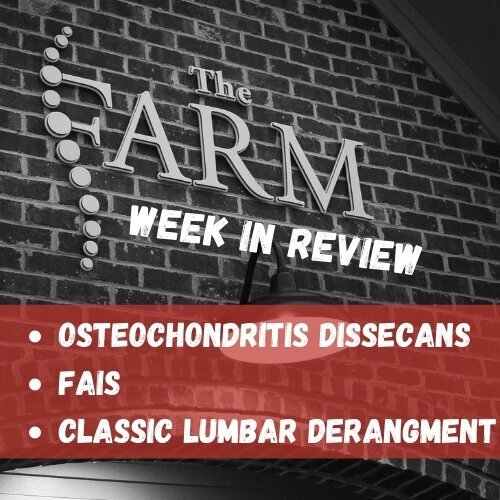Knee OCD, FAIS, and Lumbar Derangement: Week in Review
In this week’s Week in Review episode, the clinicians at The FARM tackle a trio of musculoskeletal conditions that frequently confuse, mislead, or frustrate both clinicians and patients alike: knee osteochondritis dissecans (OCD), femoroacetabular impingement syndrome (FAIS), and lumbar disc derangement. While each condition is often studied and treated in isolation, this conversation pushes listeners to think differently—to consider how biomechanics, compensatory patterns, and systemic dysfunction may overlap and distort the clinical picture.
What emerges is a compelling case for abandoning the reductionist “treat-the-joint” model and embracing a more integrated, whole-system approach.
Knee Osteochondritis Dissecans (OCD): Beyond the Lesion
The episode begins with a discussion of knee osteochondritis dissecans, a condition frequently seen in adolescents and young athletes. Characterized by a localized area of subchondral bone necrosis and potential cartilage instability, OCD has long been viewed primarily through an orthopedic and surgical lens. But the FARM clinicians challenge that limited perspective.
They highlight how OCD may be less about an isolated failure of cartilage and more about a biomechanical overload syndrome that reflects deeper systemic imbalances. In this particular case, early imaging revealed red flags: a loose fragment near the medial femoral condyle, but no overt instability. The patient had intermittent knee locking, pain with cutting movements, and vague hip stiffness—symptoms that didn’t align neatly with the knee imaging alone.
Rather than jump into a rigid protocol, the clinicians took a step back. They analyzed how the patient moved—on stairs, in squats, during gait—and discovered a pattern of excessive internal tibial rotation, weak gluteal activation, and early valgus collapse in dynamic positions. These kinetic chain dysfunctions were driving abnormal shear forces across the medial knee joint, likely contributing to the OCD pathology.
This case underscores a critical principle: diagnosis is just the beginning, not the destination. Effective treatment of OCD—or any joint lesion—requires understanding why that tissue is failing in the first place. The conversation emphasizes neuromuscular retraining, load management, and proximal control (particularly hip and trunk stability) as essential components of OCD rehabilitation.
FAIS: A Morphological Problem Meets Functional Chaos
The discussion then shifts to femoroacetabular impingement syndrome (FAIS), a condition often diagnosed via hip imaging that reveals cam or pincer deformities—bone shapes that can predispose the hip to joint impingement and labral injury. But again, The FARM team urges caution against overly simplistic thinking.
In the case presented, the patient had classic cam morphology but only mild groin pain. What was more disabling was posterior pelvic discomfort, intermittent low back tightness, and decreased hip extension during running. While imaging supported an FAIS diagnosis, it didn’t explain the full spectrum of symptoms—or the lack of consistent mechanical pain during impingement testing.
Here, the conversation pivots to one of the central themes of the episode: what looks like a hip problem might be a spine problem—and vice versa.
The clinicians explore how hip morphology (especially reduced femoral head-neck offset) can subtly shift lumbopelvic mechanics, causing the lumbar spine to absorb excessive motion and load during athletic movement. In this case, chronic underuse of hip extension and compensatory anterior pelvic tilt created an extension-based lumbar loading pattern. This not only aggravated the low back, but further limited hip mobility—setting up a feedback loop of dysfunction.
Rather than hyper-focus on the cam lesion, treatment centered around improving hip capsule mobility, gluteal recruitment in mid-stance, and decoupling the pelvis from the lumbar spine during rotation and gait. The clinicians also incorporated isometric holds and anti-extension core work to improve control through the transitional zones of the body.
The result? Less pain, better movement, and—perhaps most importantly—greater capacity for long-term resilience.
Lumbar Disc Derangement: More Than a Structural Problem
The final condition examined in this week’s episode is lumbar disc derangement, a diagnosis that can be both overused and misunderstood. Many patients with back pain receive this label after imaging reveals a disc bulge, herniation, or signs of degenerative disc disease. But what does that actually mean for clinical decision-making?
The FARM clinicians argue that too often, “disc derangement” is used as a catch-all phrase that doesn’t reflect the complexity of spinal function. Just because an image shows a disc issue doesn’t mean it’s the source of the pain—or that it should be the exclusive focus of treatment.
In one case, a young adult patient was labeled with a moderate L4-L5 disc herniation after an MRI revealed central protrusion. The assumption was that the disc was causing nerve root irritation and radicular pain. However, the clinical picture told a different story: symptoms were inconsistent, posture-dependent, and significantly influenced by stress, sleep, and core endurance.
More revealing was the fact that when the patient’s hip function improved—particularly external rotation and extension—lumbar symptoms decreased. As with the FAIS case, the line between “primary pain generator” and “secondary compensation” became increasingly blurred.
The key lesson? Structural findings must be interpreted in context, and clinicians should resist the urge to make the disc the villain. Treatment focused on building tolerance to loading, improving regional mobility and strength, and gradually expanding the patient’s movement repertoire—not “fixing” the disc.
The Common Thread: Systems, Not Silos
Although OCD, FAIS, and lumbar disc derangement might seem like unrelated diagnoses, the underlying clinical message is clear: pain is rarely confined to a single joint or tissue. Movement systems are deeply interconnected, and dysfunction in one area often manifests as symptoms somewhere else.
This interconnectedness is especially important in chronic or recurrent cases. For example:
A stiff hip may force excessive motion into the lumbar spine.
Poor trunk control can lead to knee valgus and patellofemoral overload.
Asymmetries in loading and coordination may contribute to bone stress in adolescents.
Clinicians who silo these issues risk treating symptoms rather than solving problems. That’s why The FARM’s systems-based model places such emphasis on global movement assessment, functional testing, and patient-specific load capacity.
It also requires a shift in mindset—from fixing damaged tissue to restoring efficient movement.
Key Takeaways for Clinicians
This episode is filled with clinical pearls, but several stand out:
Don’t anchor to imaging. Radiological findings are helpful but rarely definitive. Always correlate with movement and function.
Look above and below. Local pain often results from dysfunction in adjacent segments. Think regionally, not just locally.
Movement is diagnostic. Watch the patient walk, run, squat, or rotate. Patterns reveal far more than passive tests alone.
Train for capacity. Instead of avoiding movements, help patients build tolerance and robustness through progressive exposure.
Question the narrative. Every diagnosis comes with assumptions. Be willing to challenge them based on the person in front of you.
Conclusion: The FARM Model in Action
Once again, The FARM clinicians show why systems-based care is not just more effective—it’s necessary. Diagnoses like OCD, FAIS, and disc derangement can serve as helpful starting points, but they should never box in your thinking. Instead, use them as invitations to explore why the system broke down—and how it can be rebuilt with strength, coordination, and adaptability.
Whether you’re a provider, student, or informed patient, this episode encourages a deeper curiosity and a more holistic lens. At The FARM, the goal isn’t just to chase symptoms—it’s to cultivate resilient, adaptable movement for life.


